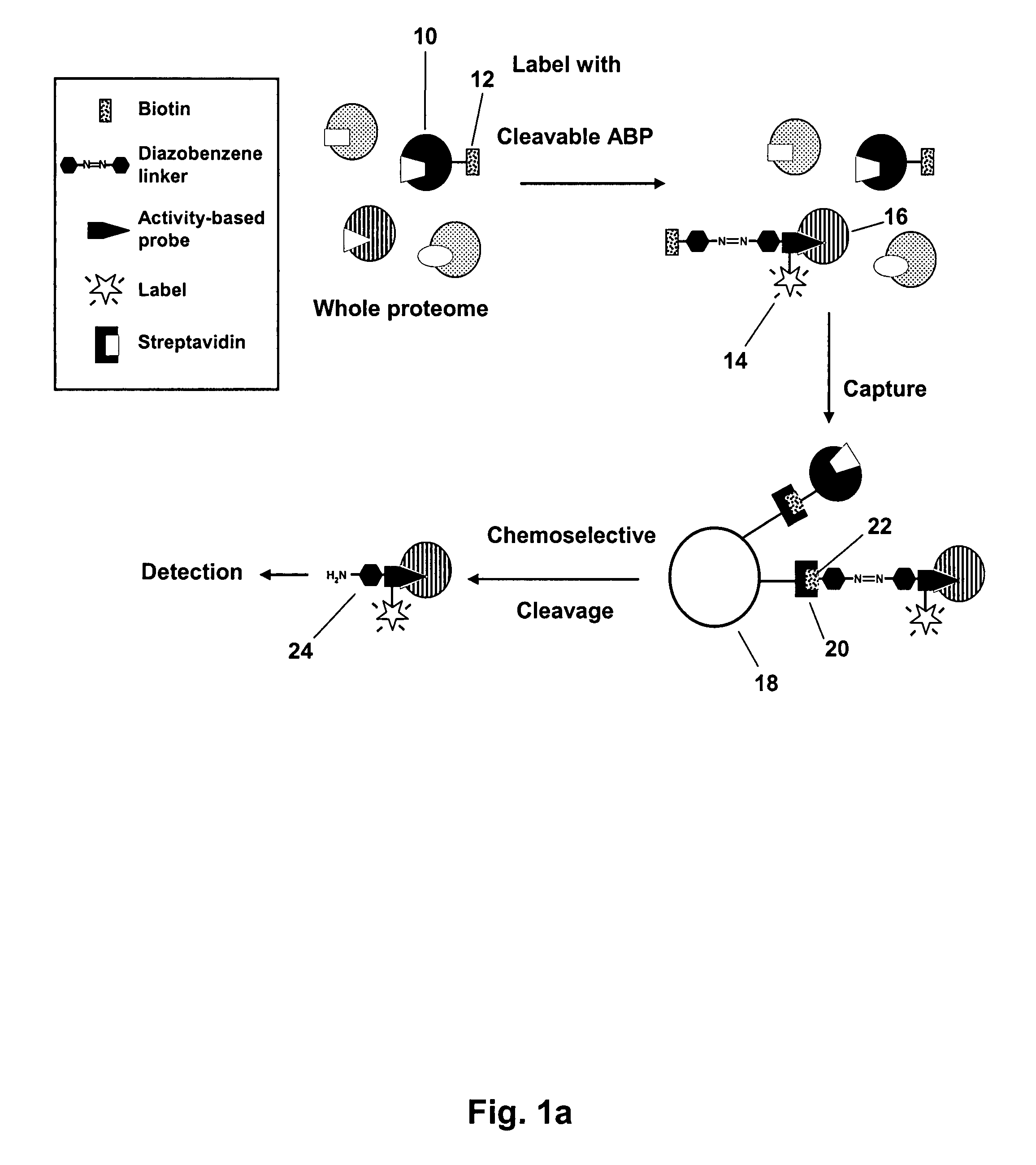Mild chemically cleavable linker system
a chemically cleavage and linker technology, applied in the field of peptide synthesis, can solve the problems of denaturing conditions that disrupt the biotin-streptavidin interaction, difficult cleavage of labeled proteins directly from strepavidin resin, and harsh conditions
- Summary
- Abstract
- Description
- Claims
- Application Information
AI Technical Summary
Benefits of technology
Problems solved by technology
Method used
Image
Examples
example 1
Preparation of 4-[5-(N-fluorenyloxycarbonyl-2-Amino-ethyl)-2-hydroxy-phenylazo]-benzoic acid (Compounds 1 and 2 in FIG. 2)
[0096]A solution of 4-carboxy-benzenediazonium chloride was prepared in the following way. Solid NaNO2 (345 mg, 5 mmol, 5 eq.) was added to a cooled suspension of 4-aminobenzoic acid (274 mg, 2 mmol, 2 eq.) in 6 M HCl (4 mL). The resulting mixture was stirred at 0° C. and turned into a slightly yellow-brownish solution. After 15 min the diazonium salt solution was slowly added to a solution of tyramine (137 mg, 1 mmol) in aqueous saturated bicarbonate. The pH of the reaction was kept basic by repeated addition of sodium bicarbonate. The mixture was allowed to slowly warm up to room temperature and was stirred overnight. Next, Fmoc-chloride (285 mg, 1.1 mmol, 1.1. eq) was added. After 1 h, the reaction was acidified with concentrated HCl. The formed solids were filtered and the filtrate was extracted with EtOAc, washed with water, dried over MgSO4 and concentrated...
example 2
Capture and Release of Proteases from Cell Lysate
[0099]We initially tested the cleavage of SV1 (shown in FIG. 3) by incubation with 100 mM Na2S2O4. After 30 minutes full cleavage of SV1 into the two aniline fragments 3 and 4 (FIG. 3) was observed using LC-MS analysis.
[0100]We next investigated the capture and release of proteases that could be selectively labeled in a complex proteome. For this analysis, the related probe SV31 (FIG. 3, bottom) was constructed to contain an additional PEG-linker (CH2—O—C2H4—O—C2H4—) and a free epoxysuccinate (instead of OEt) for increased hydrophilicity. In addition, a fluorophore (TAMRA) was introduced on the side of the probe that remains attached to the target enzymes. This feature allows rapid in gel fluorescent detection after on-bead cleavage of the diazobenzene linker and subsequent resolution by SDS-PAGE.
[0101]Accordingly, rat liver homogenate, which contains a number of previously characterized cathepsin activities,10 was incubated with tetr...
example 3
Cleavable Linker System Containing Phosphonate Reactive Group: MTS-I-49 Peptidyl Aminoalkanephosphonate
[0107]To show applicability of the cleavable linker approach for profiling of other catalytic classes of proteases in the context of other probe scaffolds, we incorporated the diazobenzene linker into the peptide backbone of the commercially available probe DAP22C to make the probe MTS-I-49 (Enzyme Systems Products, USA; This structure is shown in FIG. 5a. The reactive group is shown in oval 52 and the affinity tag, which is biotin, is shown in rectangle 50. DAP22C (the active agent) is a peptidyl aminoalkanephosphonate that has been reported to target the serine proteases cathepsin G and chymotrypsin in vitro (Oleksyszyn, J., and Powers, J. C. (1991) Irreversible inhibition of serine proteases by peptide derivatives of (alpha-aminoalkyl)phosphonate diphenyl esters. Biochemistry 30, 485-493). However, it has not been used for any proteomic applications. We used MTS-I-49 to label mo...
PUM
| Property | Measurement | Unit |
|---|---|---|
| molecular weight | aaaaa | aaaaa |
| MW | aaaaa | aaaaa |
| pH | aaaaa | aaaaa |
Abstract
Description
Claims
Application Information
 Login to View More
Login to View More - R&D
- Intellectual Property
- Life Sciences
- Materials
- Tech Scout
- Unparalleled Data Quality
- Higher Quality Content
- 60% Fewer Hallucinations
Browse by: Latest US Patents, China's latest patents, Technical Efficacy Thesaurus, Application Domain, Technology Topic, Popular Technical Reports.
© 2025 PatSnap. All rights reserved.Legal|Privacy policy|Modern Slavery Act Transparency Statement|Sitemap|About US| Contact US: help@patsnap.com



